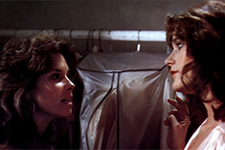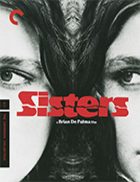Sisters
|  Sisters is Brian De Palma at his vicious, malicious best. An overt, unapologetic, and brilliantly sustained homage to Alfred Hitchcock (who, at the time, was still actively making films) that was produced independently for less than half-a-million dollars, Sisters makes up in visual ingenuity and sheer chutzpah what it lacked in budget. Shot mostly in tight, enclosed rooms, De Palma employs complex tracking shots, long zooms, fast-cut editing, and a now-famous use of precisely timed split-screen effects to weave his bloody mystery. The story concerns Danielle Breton (Margot Kidder), a French-Canadian model living on Staten Island in New York City. She meets a man named Philip (Lisle Wilson) one night when they both star on a Candid Camera-style TV game show called Peeping Toms (in fact, De Palma starts the film within Peeping Toms, and it is only after a few minutes that we realize we are inside a TV show; it’s a self-conscious trick that he would employ again at the beginning of 1981’s Blow Out). Philip goes home with Danielle that night, and the next morning he is brutally murdered by Danielle’s deranged twin sister, Dominique, who only a year earlier had been surgically separated from Danielle.Then, in true Psycho fashion, after 40 minutes of identifying with Danielle, De Palma completely shifts audience identification, placing it instead with Grace Collier (Jennifer Salt), a determined young newspaper columnist who witnesses Philip’s murder from her apartment across the street. De Palma temporarily overlaps audience identification with Grace and Danielle with the use of the split screen, tracking Grace as she calls and waits for the police on the right sight of the screen, while simultaneously tracking Danielle and her ex-husband, Emil (William Finley), as they dump Philip’s body into the hide-a-bed couch and clean up the blood. De Palma maintains the simultaneity of the two events down to the second with only minimal editing, so that we see from two angles as Grace and the police officers come up the elevator and Emil just manages to hide around a corner. His approach creates a uniquelt vexing and enthralling scenario because it tears your identification right down the middle: Are you anxious that Grace and the police will not arrive in time to catch Danielle and Amil in the act, or are you anxious that Danielle and Amil will not get the crime scene cleaned up in time? De Palma manages to pull the suspense in two opposing directions, probably his greatest feat in generating suspense and a masterly raising of the bar that Hitchcock had so studiously maintained for so long (it’s De Palma’s true bid to be the heir apparent).For most of the film’s remainder, our identification rests squarely with Grace as she becomes determined to prove that Danielle (or Dominique, who is conspicuously absent all of a sudden) killed Philip. She gets no help from the police, especially Detective Kelly (Dolph Sweet), who is bitter about the columns Grace has written condemning police brutality. (De Palma gives us a montage of Grace’s headlines, one of which read “Why We Call Them Pigs,” a not-so subtle reminder that De Palma began his career in the late 1960s with subversive antiauthoritarian satires.) Despite a search of the apartment, they don’t turn up any immediate evidence. De Palma’s blackly comic sense of humor comes out best in these scenes, especially when Grace sits down on the couch, literally on top of the dead body, and proclaims in a frustrated tone, “That body is here somewhere!”Sisters was the film that made De Palma’s career, and it was the first to fully articulate the themes and obsessions that would drive his best films throughout the 1970s and early 1980s, including Carrie (1976), Obsession (1976), The Fury (1978), and Dressed to Kill (1980). Voyeurism is a particularly recurrent thematic element in De Palma’s work, going back to his free-wheeling satire Greetings (1968), and it is stressed repeatedly throughout Sisters. One scene in particular, in which Grace watches through binoculars while a private investigator (Barnard Hughes) searches Dominique’s apartment, is directly inspired by Hitchcock’s Rear Window (1954). (De Palma giddily plays with Hitchcockian tropes, often inverting or radically altering the characters involved, so that the murderer is no longer Psycho’s shy, deranged young man, but a shy, deranged young woman, and the amateur investigator is no longer Rear Window’s incapacitated alpha male, but rather a gutsy, unrelenting feminist reporter.)De Palma has freely admitted that he made Sisters as a kind of cinematic experiment, a way for him to hone his directorial skills after making fairly loosely plotted and staged underground films like Greetings, The Wedding Party (1969), and Hi, Mom! (1970). There is nothing loose about Sisters in any sense. It as tightly plotted and tautly controlled by De Palma as any film he has ever made. It comes close to derailing in the last 20 minutes, when Grace and Danielle’s stories once again merge and De Palma uses a series of bizarre, black-and-white, hypnotic dream sequences to explain Danielle and Dominique’s twisted history and how Emil was involved in their separation (most of these scenes take place in an institution for the malformed, and the eerie quality brings to mind Todd Browning’s Freaks). Yet, even as he verges on the absurd, De Palma never tumbles over. He maintains control throughout.Thus, Sisters remains, from start to finish, a consuming film. It is exhilarating, tense, often quite funny, sometimes all at the same time. De Palma’s indebtedness to Hitchcock is obvious in just about every frame, as well as in his use of Hitch’s favorite composer, Bernard Herrmann, whose thundering score, which is reminiscent of his work on Psycho and Vertigo (1958), gives Sisters an added edge. One could drag out the tired old argument that De Palma is just a knock-off, but he uses Hitch’s methods and obsessions with such skill and aplomb that he makes them his own; the homage is there, yet Sisters is first and foremost the sign of an emerging talent coming into his own. Better than just about any other director, De Palma has matched Hitchcock’s adeptness at wielding tension and humor to, in the master’s own words, “play the audience.”
Copyright © 2018 James Kendrick Thoughts? E-mail James Kendrick All images copyright © The Criterion Collection | |||||||||||||||||||||||||||||||
Overall Rating: 


 (4)
(4)


